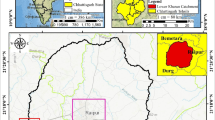Abstract
Sentinel-2 and Landsat-8 satellite images are effective ways for the Earth's surface monitoring, and their images are readily accessible for interpretation and analysis of land surface monitoring. Satellite images are frequently used in land surface monitoring applications such as urban planning, vegetation monitoring, and territorial planning administrations. The advent of satellite images has created a viable framework for tracking land changes in cities. Urban heat is thought to be the cause of higher temperature values in urban areas when compared to their surroundings. The link between the land surface and the atmosphere is influenced by land surface temperature (LST), which is an essential parameter in many scientific fields. Sentinel-2 and Landsat-8 images of Lucknow city taken over the summer months from 2017 to 2021 are used in this study to determine the correlation between urban areas and LST to assess the impact of rapid urbanization on land surface temperature rise. Urban area monitoring will be useful for policymakers in the future for planned urbanization and managing resources to develop sustainable and smart cities.
Access this chapter
Tax calculation will be finalised at checkout
Purchases are for personal use only
Similar content being viewed by others
References
Gómez C, White JC, Wulder MA (2016) Optical remotely sensed time series data for land cover classification: A review. ISPRS J Photogramm Remote Sens 116:445–467
Bhatti SS, Tripathi NK (2014) Built-up area extraction using Landsat 8 OLI imagery. GIScience Remote Sensing 51(4):55–72
Sekertekin A, Bonafoni S (2020) Land surface temperature retrieval from Landsat 5, 7, and 8 over rural areas: assessment of different retrieval algorithms and emissivity models and toolbox implementation. MDPI Remote Sensing 12(294):1–32
Li K, Chen Y (2018) A genetic algorithm-based urban cluster automatic threshold method by combining VIIRS DNB, NDVI, and NDBI to monitor urbanization. MDPI Remote Sensing 10(277):1–21
Nezhad MM, Heydari A, Fusilli L, Laneve G (2019) Land cover classification by using Sentinel 2 images: a case study in the city of Rome. In: Proceedings of the 4th world congress on civil, structural, and environmental engineering (CSEE’19), Rome, Italy, 158-1–158-8
Sahana M, Ahmed R, Sajjad H (2016) Analyzing land surface temperature distribution in response to land use/land cover change using split window algorithm and spectral radiance model in Sundarban Biosphere Reserve. Model Earth Syst. 2(81):1–11
Liu T, Yang X (2015) Monitoring land changes in an urban area using satellite imagery, GIS and landscape metrics. Appl Geogr 56:42–54
Mokadem D, Amine A, Elberrichi Z, Helbert D (2018) Detection of urban areas using genetic algorithms and Kohonen maps on multispectral images. Int J Organ Collective Intell 8(1):46–62
Guo Yiqiang W, Zhengshan YJ, Jun W, Luyan Z, Luyan Z (2010) Remote sensing image classification by the Chaos Genetic Algorithm in monitoring land use changes. Math Comput Model 51(11–12):1408–1416
Srivastava S, Ahmed T (2021) Similarity-based neural network model for FBIR system of optical satellite image quality assessment. Turkish J Comput Math Educ 12(13):2391–2410
Vigneshwaran S, Vasantha Kumar S (2018) Extraction of Built-up area using high-resolution Sentinel 2a and google satellite imagery. In: The international archives of the photogrammetry, remote sensing and spatial information sciences, vol XLII-4/W9, pp 165–168
Zhang P, He H, Wang Y, Liu Y, Lin H, Guo L, Yang W (2022) 3D Urban buildings extraction based on airborne LiDAR and photogrammetric point cloud fusion according to U-net deep learning model segmentation. IEEE Access 10:20889–20897
Al-Mulla Y, Al-Ruheili A, Al-Lawati A, Parimi K, Ali A, Al-Sadi N, Al-Harrasi F (2022) Assessment of urban expansion’s impact on changes in vegetation patterns in Dhofar, Oman, using remote sensing and GIS techniques. IEEE Access 10:86782–86792
Zhao E, Gao C, Han Q, Yao Y, Wang Y, Chunyan Y, Haoyang Y (2022) An operational land surface temperature retrieval methodology for Chinese second-generation Huanjing disaster monitoring satellite data. IEEE J Sel Top Appl Earth Observ Remote Sens 15:1283–1292
Meng X, Cheng J, Guo H, Guo Y, Yao B (2022) Accuracy evaluation of the Landsat 9 land surface temperature product. IEEE J Sel Top Appl Earth Observ Remote Sens 15:8694–8703
Anandababu D, Purushothaman BM, Dr. Suresh Babu S (2018) Estimation of land surface temperature using LANDSAT 8 data. Int J Adv Res Ideas Innov Technol 4(2):2391–2410
Li Z-L, Hua W, Wang N, Qiu S, Sobrino JA, Wan Z, Tang B-H, Yan G (2013) Review Article Land surface emissivity retrieval from satellite data. Int J Remote Sens 34(9–10):3084–3127
Neto M, Correa Victorino A, Fantoni I, Zampieri DE, Ferreira JV, Lima DA (2013) Image processing using Pearson’s correlation coefficient: applications on autonomous robotics. In: 2013 13th International conference on autonomous robot systems, Apr 24 (1–6). IEEE
Srivastava S, Ahmed T (2021) Feature-based image retrieval (FBIR) system for satellite image quality assessment using big data analytical technique. Psychol Educ 58(2):10202–10220
Jeevalakshmi D, Dr. Narayana Reddy S, Dr. Manikiam B (2017) Land surface temperature retrieval from LANDSAT data using emissivity estimation. Int J Appl Eng Res 12(20):9679–9687
Acknowledgements
The authors are thankful to the Advanced Computing and Research Laboratory, Department of Computer Application, Integral University Lucknow, India for providing support to this work. The manuscript number issued by the University is IU/R&D/2023-MCN0001799.
Author information
Authors and Affiliations
Corresponding author
Editor information
Editors and Affiliations
Rights and permissions
Copyright information
© 2023 The Author(s), under exclusive license to Springer Nature Singapore Pte Ltd.
About this paper
Cite this paper
Srivastava, S., Ahmed, T. (2023). An Approach to Assess the Impact of Rapid Urbanization on Land Surface Temperature Using Sentinel-2 and Landsat-8 Images. In: Kumar, S., Hiranwal, S., Purohit, S., Prasad, M. (eds) Proceedings of International Conference on Communication and Computational Technologies. ICCCT 2023. Algorithms for Intelligent Systems. Springer, Singapore. https://doi.org/10.1007/978-981-99-3485-0_60
Download citation
DOI: https://doi.org/10.1007/978-981-99-3485-0_60
Published:
Publisher Name: Springer, Singapore
Print ISBN: 978-981-99-3484-3
Online ISBN: 978-981-99-3485-0
eBook Packages: Intelligent Technologies and RoboticsIntelligent Technologies and Robotics (R0)




